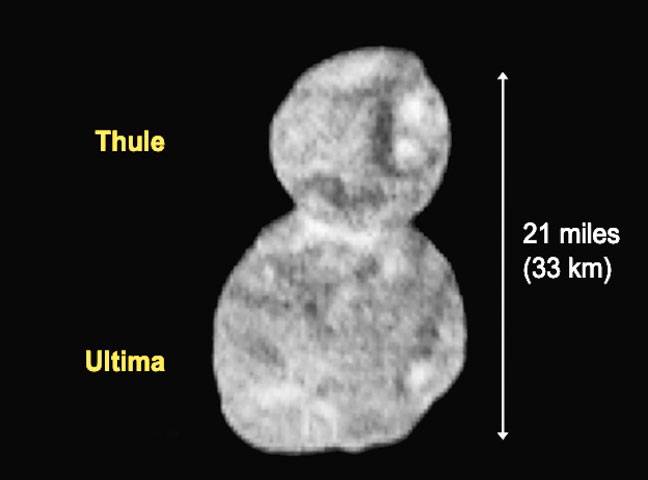NEW YORK - The small, icy world known as Ultima Thule has finally been revealed. A new picture returned from Nasa's New Horizons spacecraft shows it to be two objects joined together - to give a look like a "snowman".
The US probe's images acquired as it approached Ultima hinted at the possibility of a double body, but the first detailed picture from Tuesday's close flyby confirms it. New Horizons encountered Ultima 6.5 billion km from Earth.
The event set a record for the most distant ever exploration of a Solar System object. The previous mark was also set by New Horizons when it flew past the dwarf planet Pluto in 2015. But Ultima is 1.5 billion km further out.
It orbits the Sun in a region of the Solar System known as the Kuiper belt - a collection of debris and dwarf planets. There are hundreds of thousands of Kuiper members like Ultima, and their frigid state almost certainly holds clues to how all planetary bodies came into being some 4.6 billion years ago.
The mission team thinks the two spheres that make up this particular object probably joined right at the beginning, or very shortly after. The scientists have decided to call the larger lobe "Ultima", and the smaller lobe "Thule". The volume ratio is three to one.
Jeff Moore, a New Horizons co-investigator from Nasa's Ames Research Center, said the pair would have come together at very low speed, at maybe 2-3km/h. He joked: "If you had a collision with another car at those speeds you may not even bother to fill out the insurance forms."
The new data from Nasa's spacecraft also shows just how dark the object is. Its brightest areas reflect just 13% of the light falling on them; the darkest, just 6%. That's similar to potting soil, said Cathy Olkin, the mission's deputy project scientist from the Southwest Research Institute (SwRI).
It has a tinge of colour, however. "We had a rough colour from Hubble but now we can definitely say that Ultima Thule is red," added colleague Carly Howett, also from SwRI. "Our current theory as to why Ultima Thule is red is the irradiation of exotic ices." Essentially, its surface has been "burnt" over the eons by the high-energy cosmic rays and X-rays that flood space.
Principal Investigator Alan Stern paid tribute to the skill of his team in acquiring the image as New Horizons flew past the object, reaching 3,500km from its surface at closest approach. The probe had to target Ultima very precisely to be sure of getting it centre-frame in the view of the cameras and other instruments onboard.
"[Ultima's] only really the size of something like Washington DC, and it's about as reflective as garden variety dirt, and it's illuminated by a Sun that's 1,900 times fainter than it is outside on a sunny day here on the Earth. We were basically chasing it down in the dark at 32,000mph (51,000km/h) and all that had to happen just right," the SwRI scientist said.
Less than 1% of all the data gathered by New Horizons during the flyby has been downlinked to Earth. The slow data-rates from the Kuiper belt mean it will be fully 20 months before all the information is pulled off the spacecraft.
The best of the pictures shared by the team on Wednesday were taken while the probe was still 28,000km from Ultima and discern surface features larger than 140m across. Pictures are expected in February that were captured at the moment of closest approach and these will have a resolution of about 35m per pixel.






